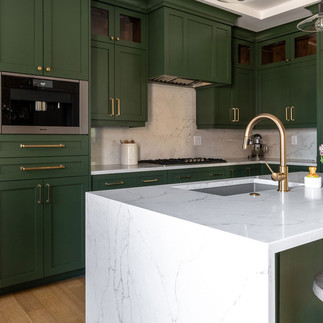Eco-Kitchen: Worktops & Backsplash
- Susan Van Meter

- Feb 8, 2022
- 4 min read
Updated: Sep 19, 2022

KITCHEN WORKTOPS.

Natural stone, mainly granite, has dominated kitchen and bathroom design for the last 20 years. In the past 5+ years, we've seen quartz get its turn in the spotlight. The quarrying and manufacturing processes for marble and other natural stones can have negative environmental impacts. That's why I love that Quartz has become a real contender for many home refurbishments.
Natural stone suppliers get annoyed with misinformation about quartz, because a lot of quartz that's made in China or Turkey use plastic-based resins, which is a pollutant.
So, it's important to do the right research into how and where the quartz is made. I have created an ‘at a glance’ list of facts about what it is, performance, and environmental impact - so you'll know what to look for!
⭐️ If you’d like to know more about marble and natural stone alternatives, download
this FREE GUIDE - 10 Alternative surfaces to natural stone and marble
QUARTZ: AT A GLANCE FACTS
Quartz is the second most abundant mineral on earth.
Many think that quartz is a stone, but it actually forms as a crystal. It has been mined for years and is commonly used in applications outside of kitchens, notably watches and electronics.
Quartz is widespread. It forms in all types of rock. When rocks are eroded over time, quartz is turned into sand or deposited in the soil as well. Most white sands are composed of quartz.
This means quartz is not usually shipped from great distances, (Although can be!) which reduces the environmental impact and boosts sustainability.

It endures longer than many other materials, this means that it does not need to be replaced as often. It is very dense and therefore incredibly heavy.
Quartz never needs to be sealed and it is not prone to cracking or staining. This means there's less exposure to harmful chemicals that are used to seal other natural stones.
It is a low-maintenance option that has superior durability over granite and other natural stone.
The surface is not porous like natural stone. Therefore, it will not stain and it is very easy to clean.
Quartz can be made with recycled materials such as glass and broken ceramics, mixed with non-toxic binders. It can then be coloured to replicate marble veining.

The material holds up well with heat, abrasive cleanings, oils, and more.
It is available in 20 or 30mm sheets or slabs.
Quartz is so durable that many manufacturers offer warranties on their quartz products.
Silica dust is a by-product of quartz in the fabrication process. That is why it is important for those working with this material to be protected as it is known as carcinogenic.
For quartz to be truly sustainable it needs to be 'glued' together (the binding agent) with a non-toxic material. Silestone uses one as do Altrock, a UK-based manufacturer.
Quartz can be handcrafted to create veins and patterns that breathe life into each surface. Pure, natural quartz is combined with pigments, resins and expert craftsmanship to mirror the inspiration we find in the natural world. Take a look at some of these gorgeous examples below. You can get the same look and feel of marble without costing the earth!
Different examples of Quartz patterns and veining
You will need a good fabricator to cut and fit your worktop, they will come and template your top for you.
To template your worktop you need the following in place:
Your base and wall cabinets fitted.
Either your actual sink or the DVF file supplied by the manufacturer so the fabricator can cut the correct size hole in the workshop.
The same for the range or hob so accurate measurements can be taken.
Items such as tap holes and socket outlets (backsplash or pop-up) can be drilled on-site.
Polished edges are normally completed in the workshop but (small sections) can also be done on-site when fitting.
⭐️ Download our free guide for a list of alternative stone and marble suppliers

KITCHEN BACKSPLASH.
Whether they make a statement because of its material, color, pattern, or texture, or a more understated design, a backsplash can be a beautiful part of the kitchen. A place for you to express your personal style and have a bit of fun!

Of course, it’s a hardworking feature, too, protecting walls from splatters, splashes, and grease as you cook, so it’s imperative that a backsplash is easy to clean to make keeping the kitchen pristine an easy task. However, if you want to go with something like copper for the aesthetic, go for it! When it comes to tiles, porcelain, quartz or ceramic are some of my favourite more eco-friendly options.
What you choose for your kitchen backsplash depends on the style of kitchen you are going for.
If budget allows, I would continue the worktop on the wall to the underside of the cabinet, in the same materials or thinner - if your supplier can do that. Otherwise, it would need to be in 20 or 30mm thickness. This can look elegant and luxurious.
I would also suggest that the junction between the back of the worktop and the wall is not left as a line of silicone - this will get dirty and look unsightly over time. It is better to finish this with a small upstand, of 100mm less or more, in the same material as the worktop.
Then, either paint the remainder of the wall or tile it - the ideal material is a washable and durable surface like a tile or stone slab. This can look striking and impressive. You can also go with a printed wall tile like the multi coloured marble imitation above (first from left) - that will definitely make a statement!
⭐️ Download the free guide if you want to see a list of alternative stone and marble suppliers CLICK HERE TO DOWNLOAD NOW ⭐️

































Comments